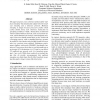Free Online Productivity Tools
i2Speak
i2Symbol
i2OCR
iTex2Img
iWeb2Print
iWeb2Shot
i2Type
iPdf2Split
iPdf2Merge
i2Bopomofo
i2Arabic
i2Style
i2Image
i2PDF
iLatex2Rtf
Sci2ools
ISCA
1999
IEEE
1999
IEEE
Multicast Snooping: A New Coherence Method Using a Multicast Address Network
This paper proposes a new coherence method called "multicast snooping" that dynamically adapts between broadcast snooping and a directory protocol. Multicast snooping is unique because processors predict which caches should snoop each coherence transaction by specifying a multicast "mask." Transactions are delivered with an ordered multicast network, such as an Isotach network, which eliminates the need for acknowledgment messages. Processors handle transactions as they would with a snooping protocol, while a simplified directory operates in parallel to check masks and gracefully handle incorrect ones (e.g., previous owner missing). Preliminary performance numbers with mostly SPLASH-2 benchmarks running on 32 processors show that we can limit multicasts to an average of 2-6 destinations (<< 32) and we can deliver 2-5 multicasts per network cycle (>> broadcast snooping's 1 per cycle). While these results do not include timing, they do provide encour...
| Added | 03 Aug 2010 |
| Updated | 03 Aug 2010 |
| Type | Conference |
| Year | 1999 |
| Where | ISCA |
| Authors | E. Ender Bilir, Ross M. Dickson, Ying Hu, Manoj Plakal, Daniel J. Sorin, Mark D. Hill, David A. Wood |
Comments (0)

